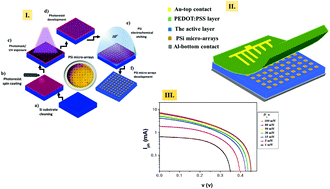Self-powered broadband hybrid organic–inorganic photodetectors based on PEDOT:PSS and silicon micro-nanostructures
Abstract
Hybrid organic–inorganic self-powered photodetectors with three different configurations were fabricated and their optoelectronic performance was determined. Si is the inorganic active layer and the transparent conductor poly(3,4-ethylenedioxythiophene) polystyrene sulfonate (PEDOT:PSS) is the organic layer. The basic photodetector structure under study is Au/PEDOT:PSS/Si/Al. This device shows high responsivity under low irradiation levels, as well as a wideband response in the visible and near-infrared wavelength ranges. To improve the performance of this basic device, its structure was modified by the addition of a nanostructured porous silicon (PSi) layer on top of the Si substrate. The resulting Au/PEDOT:PSS/PSi/Si/Al devices have been found to show improved photoresponse under high irradiation levels together with narrowband spectral responsivity in the infrared region. To further improve the optoelectronic performance of the photodetectors, Si + PSi micro-arrays were used instead of single PSi layers, leading to devices with the structure Au/PEDOT:PSS/(Si + PSi micro-arrays)/Si/Al. These devices possess a much improved performance, showing a responsivity of 1172.87 mA W−1, a specific detectivity of 5.81 × 1013 Jones, and a fast response speed of 396/412 μs at 0 V bias under white-light illumination (100 μW). Furthermore, a broadband spectral responsivity was achieved, with a maximum value of 473 mA W−1 at 853 nm. This improved behavior is associated with the combined effect of an effective reduction of the reflectance due to the presence of PSi and an improvement of the electrical conduction given by the presence of heavily-doped Si regions.



 Please wait while we load your content...
Please wait while we load your content...